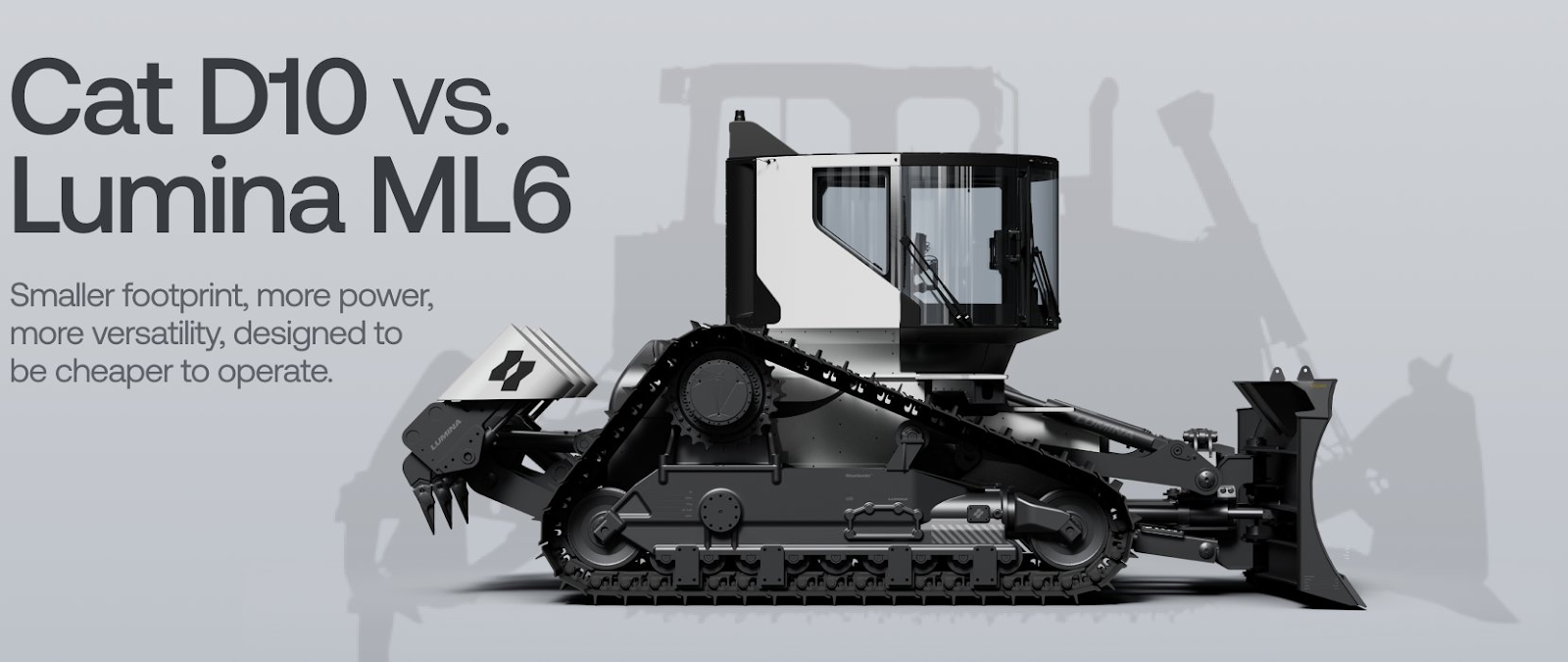
This was us:
We’re bringing on an investor who’s run excavation companies and whose LPs include major construction firms.
— Ahmed shubber (@ahmedshubber25) June 12, 2025
As we lock in our first acquisition these next few months, they’ll help guide and accelerate our growth. Excited to partner with them
Will announce soon.
Earlier this year, Shadow made an investment in Lumina.
Here is our thesis:
1/ Machine breakthrough
I’ve sat in a Lumina dozer and watched it run for hours, and it exceeds design/engineering expectations across all stretches of the imagination.
The first successful crawler tractor, Benjamin Holt’s steam‑powered “Caterpillar” of 1904, freed earth‑moving from rails and animal labor. Internal‑combustion engines arrived a decade later, giving the industry its diesel soundtrack. Over the next hundred years, equipment grew bigger and hydraulics replaced cables, but the formula remained constant: a steel frame, a combustion engine, and a skilled operator perched in the cab. Productivity gains since the 1980s have been incremental, largely from wider blades, better transmissions, GPS grade control, and marginal fuel efficiency tweaks. The basic economics did not change. Diesel fuel, maintenance costs, and machine downtime still dominate project costs, keeping contractor margins in the single digits.
Lumina represents the first engineering reset for heavy construction machinery since hydraulics displaced cable scrapers.

2/ Machine economics
Fuel + maintenance eat 30-40% of every excavation budget. Swap diesel for electric batteries and most of the cost structure changes dramatically. The Moonlander dozer will operate for roughly half the cost of a Cat D9 and last twice as long ($.33 per cubic yard compared to $.57). The operational cost advantage will only be amplified across future Lumina products (excavators, loaders, etc.)

3/ Competition trapped in the wrong quadrants
Incumbent OEMs are locked in an innovator’s dilemma: diesel parts and service are too profitable for them to prioritize EV machines, so they’ll keep releasing fringe prototypes. Challenger startups have focused on autonomy retrofits for legacy diesel iron horizontally across every project type in heavy construction, making autonomy both much more difficult to achieve (because they are horizontally stretched) and still not solving the core cost structure problem. Lumina’s approach was to start with electrification and fix the cost structure, and then layer in autonomy later to further enhance the cost advantage.
4/ Operator + OEM model
Perhaps the most contrarian thesis that Lumina has is the decision to run their machines in the field vs. sell them. I see a lot of initial skepticism. One useful metric here is margin payback: how quickly does Lumina recoup the profit from running the machines in the field vs. simply selling them? As of today’s costs, the projected payback is less than two years. The machine is expected to have a minimum life of 8 years. Self-performing the work is the most efficient and profitable way to fund growth. Contract cash flow pays for the next fleet faster than expensive venture equity.
5/ “Ahmed is n-of-one”
An existing investor told me this on the first day I met Ahmed. Which made me more skeptical that it was true. Yet, it’s true. Lumina has produced outsized results on a laughably small amount of capital. Ahmed’s vision is both differentiated and paradoxical. The more time I spent with him, the more I see it.
The best evidence I can offer is to compare where he started: https://x.com/ahmedshubber25/status/1932810398186532918
To where he is today:

Once you do that, it’s no longer a leap of faith to believe the future state is attainable:

We’re excited to help him execute along the way. Fin.
By clicking “Accept”, you agree to the storing of cookies on your device to enhance site navigation, analyze site usage, and assist in our marketing efforts. View our Privacy Policy for more information.